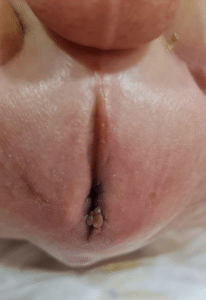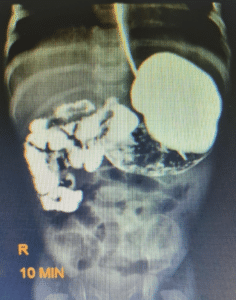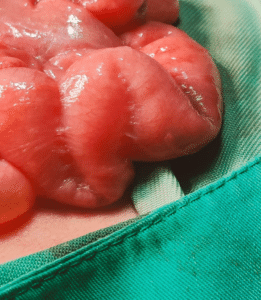Salma Abed Samamqa1*, Israa Basem Dwaik1, Reem Abuznaid1, Hadeel Raed Tomeze1, Raghad Imad Iwaiwi2, Radwan S Abukarsh2
1Al-Quds Uni, Jerusalem, Palestine
2Palestinian Red Crescent Hospital- Hebron, Palestine
*Correspondence author: Salma Abed Samamqa, Al-Quds Uni, Jerusalem, Palestine; Email: [email protected]
Published On: 01-12-2023
Copyright© 2023 by Samamqa SA, et al. All rights reserved. This is an open access article distributed under the terms of the Creative Commons Attribution License, which permits unrestricted use, distribution and reproduction in any medium, provided the original author and source are credited.
Abstract
Very Early-Onset Inflammatory Bowel Disease (VEO-IBD) and infantile IBD occur in children aged less than six years and younger than two years, respectively. Since childhood-onset IBD seems to be a more aggressive and rapidly growing disease than adult-onset IBD, it should be identified and treated as soon as possible. Here, we report the diagnosis of infantile IBD in a five-month-old child, which was confirmed by whole exome sequencing.
Keywords: Inflammatory Bowel Disease; Whole Exome Sequencing
Introduction
Crohn’s Disease (CD) is an Inflammatory Bowel Disease (IBD) subtype; it is a chronic idiopathic transmural inflammatory condition that may involve the entire gastrointestinal tract with an unclear cause [1-4]. Patients younger than 2 years old account for 1% of all IBD, with an increasing incidence readily occurring [5-11]. Compared to adults and adolescents with late-onset IBD, children with VEO-IBD had more severe gastrointestinal symptoms, including significant colonic involvement, severe colitis with hematochezia, perianal abscess and fistulae. IBD has a complicated and multifactorial etiology and monogenic abnormalities or primary immunological deficiencies are frequently linked to VEO-IBD. Many monogenic defects have been found in VEO-IBD patients in the last few decades. Early detection is crucial since a delay in diagnosis and treatment might result in failure to thrive [9].
According to recent research, severe IBD develops in the youngest children as a result of monogenic abnormalities in either IL-10 or IL-10R. About 10% of patients with VEO-IBD have IL-10RA deficiency and new variants are found all the time. Here, we present the case of a 5-month-old Palestinian baby with homozygous IL-10RA mutation-related VEO-IBD. The study reported the patient’s clinical characteristics and genetic variations and whole-exome sequencing of blood samples was used to identify the IL-10RA’s loss of function [9,12].
Case Presentation
A 5-month-old boy infant presented to the Department of Paediatrics due to diarrhea (mucoid, but sometimes with streaks of blood; about 10 episodes daily), fever, non-projectile vomiting, nonbilious vomiting and failure to thrive since birth. Multiple times, seek medical advice for treatment with unknown antibiotics and antipyretics for clinical sepsis and supportive treatment for other symptoms. But the patient still suffered from multiple episodes of fever, diarrhea and failure to gain weight after discharge. He was exclusively breastfeeding in the first three months of life, then formulas were added (Table 1).
The boy was born at 40 weeks with a birth weight of 3,300 g. Prenatal history is unremarkable, except for the history of polyhydramnios. The parents are healthy and first-degree consanguineous.
On the physical examination, the patient looked cachectic, had a body weight of 3290 g (below 3rd%), a length of 56 cm (below 3rd%), a head circumference of 37.5 cm (below 3rd %) and a body temperature of 37.9°C. There were peri-anal skin tags (Fig. 1), a napkin skin rash and a 3*3 cm umbilical hernia. The patient’s heart and lungs were all normal. A neurological examination showed no focal neurological impairment.
|
Laboratory Index |
Outcome |
Reference Range |
|
Hemoglobin (HB) |
6.3 |
110–160 g/L |
|
White Blood Cell Count (WBC) |
11.62 |
3.5–9.5 × 10− 9/L |
|
neutrophils % |
42.20% |
40% – 60% |
|
lymphocytes % |
45.70% |
20% – 40% |
|
Platelets |
128 |
150 – 450 10*3/uL |
|
Zinc |
60 |
60 – 130 µg/dL |
|
Total protein |
5 |
62–83 g/L |
|
Albumin |
2.1 |
35–50 g/L |
|
Erythrocyte Sedimentation Rate (ESR) |
70 |
0–20 mm/h |
|
C-Reactive Protein (CRP) |
32 |
0–5 mg/L |
|
Sodium (Na) |
131 |
135-145 mmol/L |
|
Chloride (Cl) |
101 |
96-106 moles/L |
|
Alanine aminotransferase (ALT) |
16 |
9–52 U/L |
|
Aspartate aminotransferase (AST) |
22 |
14–36 U/L |
|
IgM |
96 |
49-201 mg/dL |
|
IgA |
144 |
80 – 350 mg/dL |
|
IgG |
1250 |
370–1580 mg/dl |
|
IgE |
6.5 |
150 to 1,000 UI/ml |
Table 1: Shows the laboratory results, which include anemia, thrombocytopenia and coagulopathy, so Vit K stats and packed RBCs were given, as well as zinc deficiency that presents as napkin rash. Low albumin and total protein increased the suspension of intestinal lymphectasia. Numerous tests, including IgM, IgA, IgG and IgE, were conducted because of the repeated history of hospitalizations with the same complaints. The results revealed low IgE 6.5 and normal IgM, with elevated IgA 144 and IgG 1250. Further management was therefore taken into consideration. Serum electrolytes, RBS, LFT and lipid profile were all normal otherwise. The blood film revealed no blasts and normal morphology with slight WBC monocytosis. Target cells were observed in addition to anisocytosis and hypochromia of RBCs. Additionally, normal- to large-sized platelets with thrombocytopenia were seen.
On admission the patient was on an amino-acid hypoallergenic formula, the diarrhea persisted, despite trial of nothing by mouth (NPO). On the fourth day after admission, oral feeding by Orogastric Tube (OGT) was initiated, the patient developed yellowish vomiting. An upper GI study showed midgut malrotation (Fig. 2). He underwent Surgical exploration via laparotomy (ladd’s procedure) and the following findings were observed: tight inflammatory adhesions between small bowel loops and cecum (Fig. 3), also between cecum and umbilical hernia sac and nodular mucosa with widening of the base of the mesentery. Biopsies were taken from the right colon due to suspicion of VEO-IBD at the time of surgery.

Figure 1: Perianal skin tag.

Figure 2: Upper GI study showed malrotation.

Figure 3: Severe adhesions between bowel loops.
The patient kept NPO postoperative Day 2/3 on a Nasogastric Tube (NGT) for free drainage, which produced small amounts of gastric secretion. On day 3 post-operation, the patient developed bradycardia and apnea, which required intubation and mechanical ventilation and was admitted to the Paediatric Intensive Care Unit (PICU). A trial of oral feeding was started on day 7 post-operation. A greenish vomit developed, so NPO returned. The patient developed abdominal distention and greenish residue on day 10 after the operation. An abdominal X-ray showed a football sign with evidence of perforation. A penrose drain was inserted because he was not fit for surgery due to abnormal coagulopathy (low platelets, high INR), the greenish material got out, a possible anastomotic leak, a colonic fistula, or perforation due to poor healing from his critical situation. So, patients kept NPO, with the replacement of ongoing losses and antibiotics.
The colonic biopsy result showed severe active pancolitis with focal transmural inflammation, mucosal ulceration, serosal oedema and moderate active inflammation; no granuloma or microorganisms were noticed. The biopsy from the appendix showed focal serositis and active inflammation, including cryptitis and crypt abscess. The histopathologic findings and the patient clinical data showed evidence of panenteric inflammation with IBD-like features. Skin biopsies and blood samples were taken to do Whole Exome Sequencing (WES). A significant deletion variant was identified; it’s likely a pathogenic mutation on Chr11q23.3 and the affected gene was IL10RA (Table 2).
|
Location |
Chr11:117,857,182-117,860,335(3kbp) |
|
Effect |
DEL |
|
Zygosity |
HOM |
|
Cytogenetic band |
11q23.3 |
|
# Affected gene |
IL10RA |
|
# Affected enhancer |
3 |
|
Quality score |
112.00 |
|
ACMG Classification |
Likely Pathogenic |
Table 2: Single exome analysis report.
Unfortunately, he died in the hospital at the age of 5.5 months due to complications of post-surgical site cutaneous fistula leak and intestinal perforation, despite full medical management and Intensive Care Unit (ICU) support. It is deserving of note that written consent regarding reporting this case was obtained from his parents.
Discussion
Crohn’s disease is an inflammatory bowel disease subtype. It is a complicated multifactorial chronic gastrointestinal illness [1,2,4]. Consanguinity is a powerful predictor of IBD and the incidence is growing in the pediatric age group, while the percentage of infantile and neonatal disease is only 1% of pediatric overall [7]. Genes, the immune system and the usual flora in the intestines all have a role in the etiology of Crohn’s disease. The genes are crucial for maintaining the integrity of the intestinal epithelial barrier, inflammatory cells and the equilibrium between pro- and anti-inflammatory responses [1,2,8]. IL-10 is made up of two IL-10R1 subunits (encoded by IL-10RA) and two IL-10R2 subunits (encoded by IL-10RB). Signal Transducer and Activator of Transcription 3 (STAT3) is phosphorylated as a result of this complex’s activation of Janus Kinase-1 (JAK1) and Tyrosine Kinase-2 (TYR2). This promotes the production of downstream anti-inflammatory genes and has an anti-inflammatory effect [2,3,6,9]. According to recent research, 10% of VEO-IBD cases are caused by mutations in the IL-10RA gene, which mainly manifest as severe gastrointestinal symptoms in young children [1-3]. As IBD in very young children can be resistant to many of the standard medications for IBD, they require strong-growing therapeutic medication to achieve complete remission, parenteral nutrition, early administration of steroids and immunosuppressants and more surgical medicine [8]. Infantile-onset, or Very Early-Onset, IBD (VEO-IBD) differs from adult-onset or adolescent-onset IBD in terms of clinical characteristics and responsiveness to standard medication [7]. The fact that VEO-IBD patients frequently have a significantly stronger family history and genetic component to the disease is another difference [6]. The most common symptoms of pediatric Crohn’s disease are diarrhea of unknown cause (82.26%), mucous stools, bloody purulent stools, or bloody stools (69.57%) and fever (65.52%). Oral lesions are infrequent in 4.8% of patients [1]. The diagnostic process for infantile inflammatory bowel disease is the same as for adults [4]. Inflammatory markers such as Complete Blood Count (CBC), albumin, immunoglobulins and lymphocyte subsets, as well as histological findings, are essential in diagnosis [4]. Genetic tests such as exome sequencing are the most effective and accurate in screening, diagnosis and treatment [2]. Genetic counseling for family members should be addressed, management choices such as biological therapy, stem cell transplantation and surgical interventions are dependent on severity, mutation and clinical picture [1,2,4].
Many differential diagnoses were addressed in our case based on the clinical picture and presentation, which caused a delay in referral and diagnosis. Cow milk allergy was suspected based on the chronic diarrhea since birth, but it was ruled out after a trial of changing formula; enteropathies were also ruled out after the biopsy results; and cystic fibrosis and immunodeficiency were also ruled out. Sweat chloride testing for cystic fibrosis was avoided because false negative results were likely due to the wasting of muscles. In this report, we discussed the situation of a male patient whose illness started when he was a baby. The patient had a history of anal fissures, a perianal abscess at age 3, persistent diarrhea, failure to thrive and perianal tags with a recurring history of infections. Increasing inflammatory markers like ESR and CRP, which are often elevated in Crohn’s disease, along with intraoperative findings of bowel adhesions and inflammation and biopsy results, all point to inflammatory bowel illness and possibly Crohn’s disease [4]. The affected gene was IL10RA and the whole exome sequence findings obtained after death revealed homozygosity-likely pathogenic deletion mutation in Chr11:117,857,182-117,860,335 (3 kbp). He did not receive any special medical therapy as a result of the ineffectiveness of medical treatment and the delay in diagnosis. Despite comprehensive supportive care, he died as a result of septic shock and DIC with multiorgan failure.
Few patients with malrotation and IBD have been documented [7]. Five examples of intestinal malrotation in adults with concomitant Crohn’s disease and midgut malrotation were reviewed and reported by Silverman J [8]. More research is required to determine whether there is a connection between these two conditions in pediatrics and if there is a genetic relationship that is responsible for their occurrence [9-11].
Conclusion
Evaluation and confirmation of inflammatory bowel disease should be done for any child displaying signs of recurrent infection, chronic diarrhea and failure to thrive. Rare monogenic disorders that affect intestinal immune and epithelial function can lead to VEO-IBD and severe phenotypes. Clinical and genetic data are used in the diagnosis of various disorders.
Conflict of Interest
The authors have no conflict of interest to declare.
References
- Lv H, Qiao B, Fang L, Yang L, Wang Q, Wu S, et al. Neonatal Crohn’s disease with oral ulcer as the first symptom caused by a compound heterozygote mutation in IL-10RA: a case report. Hereditas. 2019;156(1):1-0.
- Oh SH, Sung YH, Kim I, Sim CK, Lee JH, Baek M, et al. Novel compound heterozygote mutation in IL10RA in a patient with very early-onset inflammatory bowel disease. Inflammatory Bowel Dis. 2019;25(3):498-509.
- Shim JO, Seo JK. Very early-onset Inflammatory Bowel Disease (IBD) in infancy is a different disease entity from adult-onset IBD; one form of interleukin-10 receptor mutations. J Human Genetics. 2014;59(6):337-41.
- Cheema HA, Waheed N, Saeed A, Fayyaz Z, Anjum MN, Alvi MA, et al. Very early onset inflammatory bowel disease: Spectrum of clinical presentation, diagnostic tools and outcome in children. JPMA. 2021;71(2350).
- Iida C, Tatsumi A, Fujino H, Anzai K, Sumimoto S. Infantile inflammatory bowel disease in a three-month-old-boy. Cureus. 2021;13(1).
- Shim JO, Seo JK. Very early-onset Inflammatory Bowel Disease (IBD) in infancy is a different disease entity from adult-onset IBD; one form of interleukin-10 receptor mutations. J Human Genetics. 2014;59(6):337-41.
- Josyabhatla R, Tatevian N, Tchakarov AS, Cox Jr CS, Van Arsdall MR. Chronic diarrhea in an infant with malrotation: a diagnostic dilemma. JPGN Rep. 2022;3(2):e177.
- Silverman J, Salwen B, Goren I, White I. Concomitant intestinal malrotation and Crohn’s disease: a rare and surgically challenging anomaly. J Surgical Case Rep. 2022;2022(4):rjac152.
- Dong F, Xiao F, Ge T, Li X, Xu W, Wu S, et al. Case report: a novel compound heterozygous mutation in IL-10RA in a Chinese child with very early-onset inflammatory bowel disease. Front Pediatrics. 2021;9:678390.
- Ebrahimi S, Khademi G, Jafari SA, Nejad NZ, Norouzy A, Imani B. Neonatal presentation of unremitting inflammatory bowel disease. Iranian J Med Sci. 2018;43(3):328.
- Shim JO. Recent advance in very early onset inflammatory bowel disease. Pediatric Gastroenterol, Hepatol Nutr. 2019;22(1):41-9.
Article Type
Case Report
Publication History
Received On: 03-11-2023
Accepted On: 22-11-2023
Published On: 01-12-2023
Copyright© 2023 by Samamqa SA, et al. All rights reserved. This is an open access article distributed under the terms of the Creative Commons Attribution License, which permits unrestricted use, distribution, and reproduction in any medium, provided the original author and source are credited.
Citation: Samamqa SA, et al. Neonatal Crohn’s Disease Caused by Compound Homozygous Mutation in IL-10RA: A Case Report. J Surg Res Prac. 2023;4(3):1-6.

Figure 1: Perianal skin tag.

Figure 2: Upper GI study showed malrotation.

Figure 3: Severe adhesions between bowel loops.
Laboratory Index | Outcome | Reference Range |
Hemoglobin (HB) | 6.3 | 110–160 g/L |
White Blood Cell Count (WBC) | 11.62 | 3.5–9.5 × 10− 9/L |
neutrophils % | 42.20% | 40% – 60% |
lymphocytes % | 45.70% | 20% – 40% |
Platelets | 128 | 150 – 450 10*3/uL |
Zinc | 60 | 60 – 130 µg/dL |
Total protein | 5 | 62–83 g/L |
Albumin | 2.1 | 35–50 g/L |
Erythrocyte Sedimentation Rate (ESR) | 70 | 0–20 mm/h |
C-Reactive Protein (CRP) | 32 | 0–5 mg/L |
Sodium (Na) | 131 | 135-145 mmol/L |
Chloride (Cl) | 101 | 96-106 moles/L |
Alanine aminotransferase (ALT) | 16 | 9–52 U/L |
Aspartate aminotransferase (AST) | 22 | 14–36 U/L |
IgM | 96 | 49-201 mg/dL |
IgA | 144 | 80 – 350 mg/dL |
IgG | 1250 | 370–1580 mg/dl |
IgE | 6.5 | 150 to 1,000 UI/ml |
Table 1: Shows the laboratory results, which include anemia, thrombocytopenia and coagulopathy, so Vit K stats and packed RBCs were given, as well as zinc deficiency that presents as napkin rash. Low albumin and total protein increased the suspension of intestinal lymphectasia. Numerous tests, including IgM, IgA, IgG and IgE, were conducted because of the repeated history of hospitalizations with the same complaints. The results revealed low IgE 6.5 and normal IgM, with elevated IgA 144 and IgG 1250. Further management was therefore taken into consideration. Serum electrolytes, RBS, LFT and lipid profile were all normal otherwise. The blood film revealed no blasts and normal morphology with slight WBC monocytosis. Target cells were observed in addition to anisocytosis and hypochromia of RBCs. Additionally, normal- to large-sized platelets with thrombocytopenia were seen.
Location | Chr11:117,857,182-117,860,335(3kbp) |
Effect | DEL |
Zygosity | HOM |
Cytogenetic band | 11q23.3 |
# Affected gene | IL10RA |
# Affected enhancer | 3 |
Quality score | 112.00 |
ACMG Classification | Likely Pathogenic |
Table 2: Single exome analysis report.


